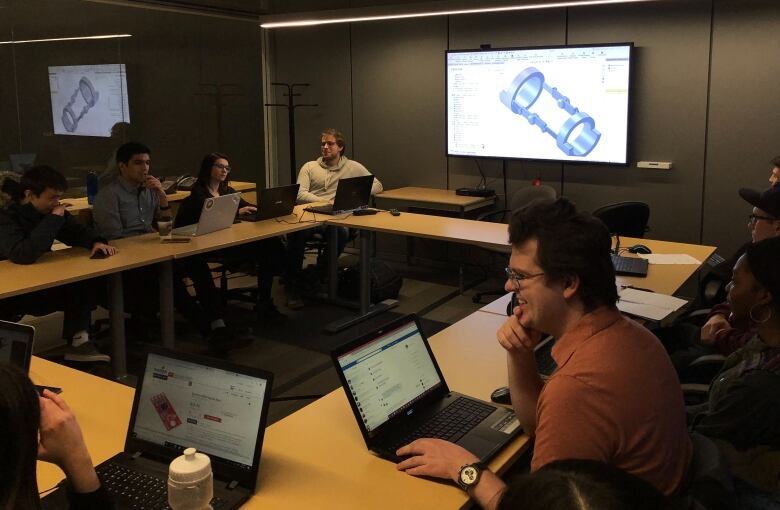An exoskeleton for jobs that require the brains of a human and the body of a robot
U of A design aims to support workers doing repetitive, mechanical tasks

There are certain jobs — physical, repetitive, assembly-line type jobs — that require the brains of a person and the body of a robot.
A University of Alberta student team is hoping to help by building a powered, Iron Man-like upper-body exoskeleton that a worker would just slip on like a jacket.
"It's a bridge for tasks which can't be automated in the near future and still require human input," said Ben Hallworth, student and co-founder of a campus biomedical engineering club.
"We really want to get humans to be at the same level as the robot, but a lot more advanced," Hallworth told CBC Radio's Edmonton AM on Tuesday. "Really bridging the gap between the simple, automated tasks and more nuanced tasks that humans are still the experts with."

The idea is to build physical support for people who, for example, do a lot of work with their arms raised over their heads. The exoskeleton would augment their strength, reduce the likelihood of injury, and offer feedback about the wearer's posture or lifting technique.
Hallworth said the group foresees a time when putting on an exoskeleton could become as common as donning any other piece of personal protective equipment. Versions of such devices are already being used in commercial settings, he said.
- How a 'bionic' vest is boosting human abilities at a Ford plant
- Robotic exoskeleton helping Denny Ross find his footing once again
"Any sort of environment where you see repetitive, highly mechanical tasks … could potentially benefit from this technology."
Hallworth said the existing systems are spring-driven while the U of A prototype will be motor-powered. The other key difference, he said, is the sensing and biofeedback properties that are designed to prevent unhealthy motion and potential injury.
The University of Alberta Biomedical Technologies Development Group started in 2018. It has more than 40 members with expertise in a number of different disciplines, including computing science, engineering, neuroscience, kinesiology and business.
The group joins several other U of A biomechanics initiatives, including the BLINC (Bionic Limbs for Improved Natural Control) Lab and the Rehab Robotics Lab.
The team plans to enter the exoskeleton into an international competition for biomedical engineering designs. Hallworth said the group is working to build a small-scale prototype of the exoskeleton's elbow to use in its entry.
The competition, called Design by Engineering Biomedical Undergraduate Teams, looks at a range of criteria, including the uniqueness of the prototype, the clinical need and possibilities for commercialization.
"We have teams specifically aimed at these goals," said Hallworth. "They're looking at the potential market for a system like this, and the scale of what impact it could actually have — proving that it's not a pie-in-the-sky idea but something that you could actually see implemented in the factory floor in five or 10 years time."